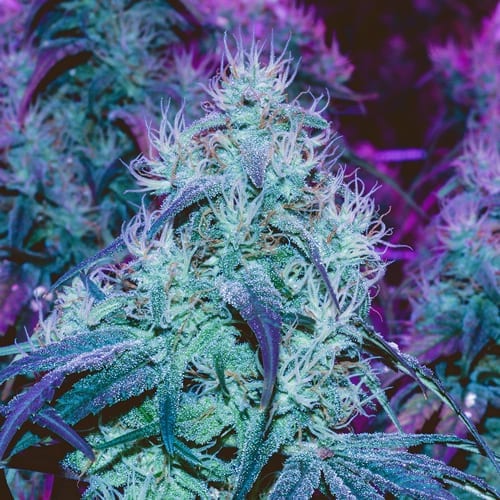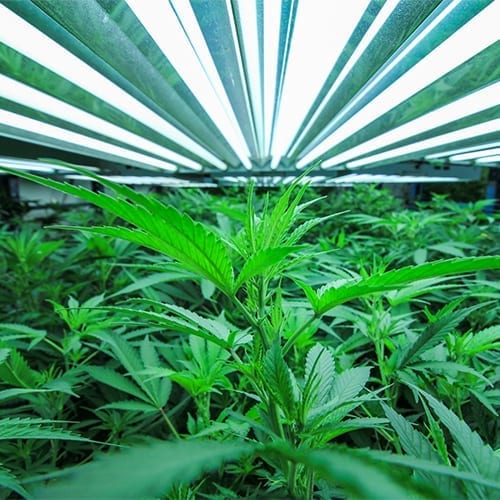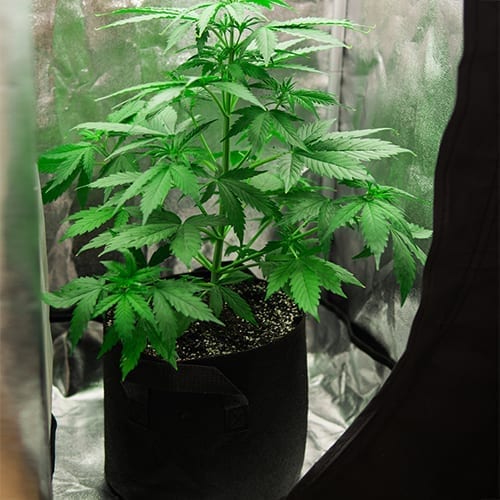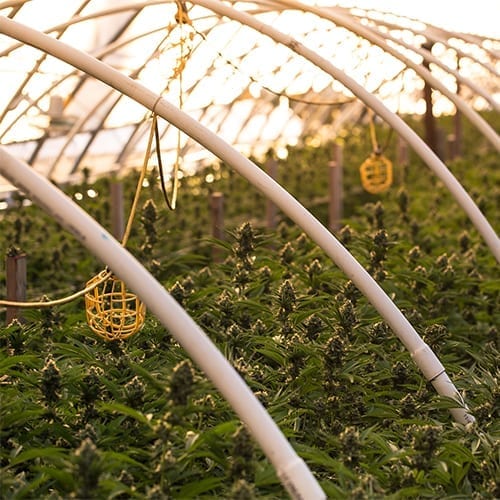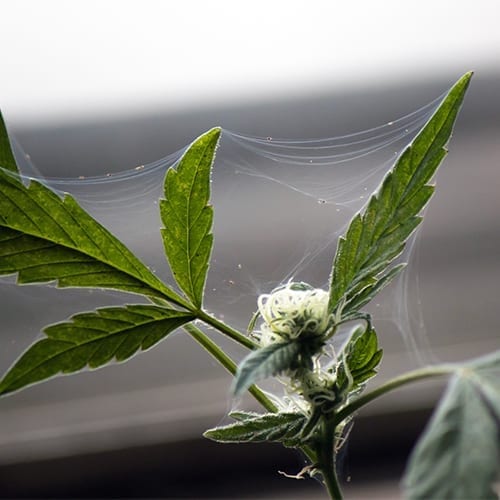
Almost any cannabis grower has had to deal with some type of pest at one time or another. Pests and diseases can be carried by vectors, living organisms that carry insects, spores or viruses without even noticing and spread them around, thus affecting nearby plants. Normally, humans, animals and other plants carried by humans are the most commonly found vectors.
If we want to have a crop free from these annoying plagues, we should follow a number of simple steps: prevention, identification, management and eradication. Some of the pests affecting marijuana plants can be devastating if not treated early, so proper prevention of these potential threats is crucial. Also, as soon as we observe any problem, we should quickly identify its source: is it an insect? A mold? A virus?
In this post we’ll elaborate a brief list of the most common pests and diseases in cannabis plants and tell you how to prevent and get rid of them.
Insects, mites and marijuana plants
There are literally hundreds of insects and mites associated with cannabis. For this reason, we’ll only take a look at the most commonly found pests in our beloved plants.
- Spider Mites are probably the most common pest in indoor grow tents and rooms – also in outdoor greenhouses – and can quickly devastate a crop in optimal growth conditions. High temperatures, low humidity levels and poorly ventilated areas are perfect for their propagation. Normally, they will first attack the lower leaves and then the youngest shoots of the plant. The first symptoms are tiny yellow dots on the surface of the leaves; if you turn the leave upside down, you’ll see small red/yellow dots on the underside of the leaf, which are spider mites. In severe cases, they develop a spider web which covers the tops of the plants. The most common types of spider mites are Tetranychus urticae and Tetranychus cinnabarinus.
- Aphids are another threat to our plants, not only for the damage that they can cause but also because they act as vectors of several viruses and diseases. They are mostly found on the stems and the underside of the leaves, and can establish a symbiotic relationship with other insects like ants or bees. Aphids exudate honeydew from the anus, which can be observed with the naked eye. As many insects do, they suck sap from the plant.
- Thrips are another common pest in cannabis plants, especially in greenhouses and indoor grow rooms. Frankliniella Occidentalis is, probably, the most common type of thrip found in marijuana crops. These small winged insects also live on the underside of the leaves, leaving white/silver stains on the surface. In severe cases, plenty of black dots can also be observed, which are thrip droppings. Thrips like warm climates and, while being poor flyers, can also act as pest/disease vectors.
- Caterpillars and budworms can represent a serious menace to outdoor crops, not only for their eating action, but also because they often attack the plants during the flowering stage, and they normally develop molds in those areas where caterpillars have fed. Some species can spin loose webs and skeletonize leaves. As we have mentioned, caterpillars and budworms often come together with molds like botrytis.
- Sciarid flies – Sciaridae – are a very common pest in cannabis crops, especially when the growing media is too moist and there is not enough light intensity. They are small flying insects (3-5mm) that can cause severe damages in the root area when they are larvae, besides improving the chances of fungal attacks. Hydroponic and automated watering systems are more likely to be attacked by this pest. Reducing the irrigation frequency and amount works great to combat sciarid flies, also using some type of mulching.
- Whiteflies are hemipteran insects of about 2mm in length and witish/yellowish colour. They are mainly found on the underside of the leaves, where they lay their eggs (around 200 eggs per laying). As also happens with aphids, white flies like warm, moist weather. Chlorosis and necrosis of the leaves are the typical symptoms of this pest, caused by the sucking action of these flying insects.
- Mealybugs can also represent a serious threat to outdoor plants. These insects (family Pseudococcidae) suck sap from the plants and secrete honeydew, which will in turn attract ants, aphids and improve the growth of sooty mold.
Molds and cannabis plants
Molds can cause serious damage to cannabis crops, especially in mostly Indica hybrids and during the flowering stage. While there is a wide range of molds that can attack marijuana, only a few represent common threats to marijuana plants.
- Powdery Mildew – also called Oidium or White Mold – can become a pain in the neck for both indoor and outdoor growers if not treated early, since it can quickly ruin the smell and taste of the buds if growth conditions are optimal. Small strains of white powder can be observed on the surface of the leaves at early stages, which will become larger as the attack advances. If not treated, it will reach the bud leaves and the bud itself, ruining the crop.
- Botrytis or Gray Mold mostly affects outdoor plants, although it can also be found in indoor grow rooms. It usually appears at the late stages of the flowering period, causing severe damage to buds. High humidity levels enhance the growth of this mold, as well as high differences between day-time and night-time temperatures. We can observe necrosis on leaves and buds, also on stems. The texture of the plant changes and becomes pale-grey, developing a cotton-like substance. As we mentioned above, caterpillars and budworms often bring Botrytis attacks.
- Fusarium is the name of a large genus of filamentous fungi which are associated with plants and found in the growing media. It infects the root area and then reaches all parts of the plant through the vascular bundles. The plant dries out even if the soil is moist, and soon dies. Treating Fusarium is almost impossible, so proper prevention is crucial.
- Pythium is, actually, a group of root fungi that, as Fusarium, can infect different parts of the plant. It can either infect seeds or stems, using the plant cells to propagate. It can cause damping off in seedlings and young plants, also root rot. While – as happens with other pests – we can find different chemical treatments to combat Pythium, prevention is always recommended.
- Most Alternaria species are known as plant pathogens, which can cause severe damages to a large number of plants, including marijuana. It also affects humans, so prevention is especially important. Leaves of plants infected by Alternaria develop mottled patterns of dark and light green areas, which soon become brown and necrotic. Proper ventilation and avoiding excessive irrigation are basic factors for preventing Alternaria.
- Root rot is, most times, caused by Phytophthora, a genus of Oomycetes which attack plants. Today, we know about more than 100 species of Phytophthora, many of them being plant pathogens. Optimal growth conditions are warm, moist soil and temperatures between 15 and 24ºC. While the cell walls of fungi are made of chitin, those of Phytophthora are made of cellulose. The overall growth of the plant is slowed, and leaves show symptoms of chlorosis. The plant is withered, developing brown colour, and finally dies. Prevention methods are the most effective way to deal with root rot.
Marijuana and viruses
Besides insects and molds, plants can also be attacked by viruses. Plant viruses need living organisms to be carried, which are called viral vectors. Vectors can be either some of the mentioned pests or the grower himself, who can carry viruses from one area to another without noticing about it.
Since viruses don’t usually have an effective treatment, prevention is crucial to avoid infections, which are often devastating. Identifying viruses is also difficult, since they are often confused with insect pests or nutrient imbalances.
Fungus gnats and cannabis plants
What are Fungus gnats?
Fungus gnats or sciarid flies (sciaridae), are small flying insects of the diptera order with a size between 3 and 5mm. These small, dark coloured flies usually appear on the lower parts of the plants and in the substrate. They feed on molasses, sugars and decomposing organic material. Their favourite environmental conditions are low light intensity and high humidity, as well as warm temperatures; thus, they are common guests in greenhouses and indoor crops. Hydroponic systems are especially sensitive to this pest, although organic substrates with excess moisture are also an excellent habitat for these insects.
There currently are about 1.700 species of sciarid flies known. Still, it’s estimated that the total number of species in this family can reach around 20.000 (located mostly in the tropics), 600 of them established in Europe. Their body and wings are dark and elongated, and in many species the females are wingless.
Propagation of fungus gnats
As we have said, sciarid flies require poor lighting and humid, warm conditions for proper development and reproduction. After the pairing between male and female, they lay around 50-200 eggs in the substrate, which hatch after 48-72 hours under favorable conditions. Then, and during the next 2-3 weeks, the larvae pass through four different development stages before reaching the adult stage. In its last stage, larvae are white with black head, and measure approximately 5mm in length.
At this point, they spin a cocoon and emerge as adults about 72 hours later. Depending on environmental conditions, their propagation can be fast enough to cause problems in the crop. Thus, proper prevention is essential for effective control of this insect.
Symptoms and damages caused by fungus gnats on cannabis plants
As happens in many cases, this plague can cause direct or indirect damage to the plants. Larvae mainly cause direct damage: they feed by chewing the fine root-hairs, thus affecting nutrient uptake and increasing the chances of fungal infections in the roots like the feared Pythium. Indirect damage is caused both by larvae and adults, leading to diseases, virus infections, or fungal growth.
The typical symptoms of this pest are a slowdown of the plant’s growth, sometimes followed by fungal infections as the aforementioned Pythium or others such as Phytophtora, Fusarium, Verticilium or Botrytis.
Prevention and management of fungus gnats on cannabis plants
As we always say, it is much better to prevent a pest than to combat it. In this case, we should maintain moderate humidity and never over-water our plants; keeping the top layer of substrate dry will greatly reduce the presence of these insects, since over-watered growing media is the perfect habitat for the larvae. Another solution is covering the substrate with vermiculite or some type of mulching so adult females can’t lay their eggs in the top layer of the substrate.
Neem flour is an effective control method of this pest. This product is ideal to combat pests in the substrate, whether flies, larvae or any other insect are feeding upon the roots. After watering the plants, pour neem powder on the substrate until forming a thin layer. This layer “seals” the substrate so no adults can lay eggs on it, and no larvae can emerge from it.
As happens with many flying insects, the use of yellow sticky traps will cause a large number of casualties among adults, reducing their population and, consequently, their reproduction rate. We can also water the plants regularly with neem oil diluted in water or with some insecticide soap . There are also numerous home remedies such as using lemons with cloves (this aroma repels the insects) and spraying the substrate and lower parts of the plant with cinnamon or mint based insecticides, or with vinegar diluted in water, etc.
Biological control of fungus gnats on cannabis crops
With regard to biological control, we have several alternatives. We can use Steinernema feltiae, a microscopic entomoparasitic nematode that feeds on insects without affecting plants, animals or the environment. Another option is the predatory mite Hypoapsis Milesor the beetle Atheta Coriaria, both efficient weapons against this pest, especially larvae.
If we choose chemical insecticides – and we always suggest their responsible use as a last, desperate choice because of possible negative effects on other living beings and the environment – we can try Diazinon, sold by various brands, or some imidacloprid-based insecticides for cannabis (use half the dosage indicated by the manufacturer and check results). Usually, a single application – or two at most – will be enough to eradicate the pest.
Remember that observing proper maintenance and hygiene practices in our growing space will reward our efforts with a clean harvest of top quality buds. As the saying goes… better safe than sorry!
Source: www.alchimiaweb.com


